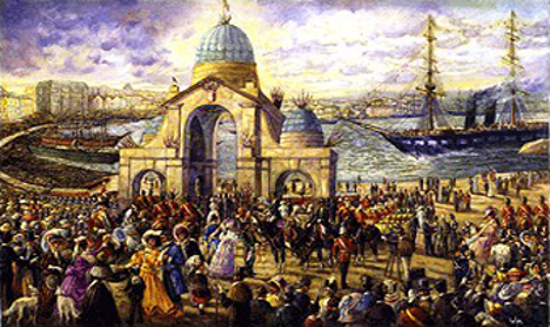Project Description
1848-1868
In terms of impact, extravagance and sheer length of time, no Royal tour to Australia has ever equalled the first: That of H.R.H. Prince Alfred, Duke of Edinburgh, between 1867-1868. It was a momentous occasion for Australia; an official chronicler of the time expressed the general feeling in stating that it was “the brightest page of our Colonial History” .
He was the second son of Queen Victoria, and fourth in line to the throne. In 1866 he was appointed to the command of H.M.S. Galatea, a 3,291-tonne steam frigate which was one of the fastest and most modem ships of the British fleet. With auxiliary steam engines of 597 horse-power, she had a top speed of 13 knots; but she was also rigged with sails that enabled her to sail independently of the engine. The Galatea also had eighteen ten-inch guns, a large storage of provisions and equipment, and two small steam-powered launches appropriately named Acis and Polyphemus. She was the most powerful and significant vessel to have ever entered Australian waters.
After visiting Adelaide, Melbourne, Ballarat, Bendigo and Hobart he sailed north for Sydney, into the most significant part of the tour yet. The Galatea was first sighted near the southern approach of Sydney’s Heads on 21st January, 1868, a day the Sydney Morning Herald described as having “a misty atmosphere” and the Melbourne Age as “light but steady rain”. She passed through a double line of 22 ships near Watson’s Bay, and then past 24 ships forming a guard of honour as she sailed by Point Piper. There were guns booming and cheers resounding as the Galatea moved up the Harbour and into Circular Quay, when suddenly, as if to add to the dramatic air of the occasion, the rain stopped pelting down and shafts of sunlight shone through the breaks in the clouds.
A massive Welcoming Pavilion had been erected on the Quay at the bottom of Loftus Street where the Galatea would dock. It was described by Sir Henry Parkes as being “out of the Taj Mahal”. The ornamental structure, made from canvas, wood and paint, had two cupolas on each side of a Great Arch and a large central dome rising from a colonnaded base. Its exterior was decorated with flags, banners, shields, and pictures of lions and heads impaled on spears.
The Galatea can be seen in the painting drifting slowly into the main berth of the Quay, just to the right of the centrally positioned arched Pavilion.
When the ship docked, Prince Alfred alighted from the vessel onto the Pavilion’s platform where he was welcomed by Sir Henry Parkes, the Premier of New South Wales, and Lord Belmore, the Governor. Under the Welcoming Pavilion gathered many officials to greet the Prince, all drenched under its leaking roof. Surrounding the Pavilion were regiments of soldiers and police, and just next to it can be seen standing a coach ready to drive Prince Alfred through the city to Government House. Towards the bottom of the painting, the wealthy and respected members of Sydney’s social elite can also be seen, gathered just beyond the military. In the distance of this scene, to the left, are the thousands of spectators that congregated around the streets of Circular Quay to express their loyalty and patriotism.
From this reception point, the Prince was driven through the crowds and into the city. Sydney had successfully outdone all the other cities in the scope and size of its display, even though it had abandoned the original idea of constructing a suspension cable across the Heads of Sydney Cove, along which patriotic banners would have been hung. In addition to the welcoming arch were other triumphal arches erected throughout the city.
